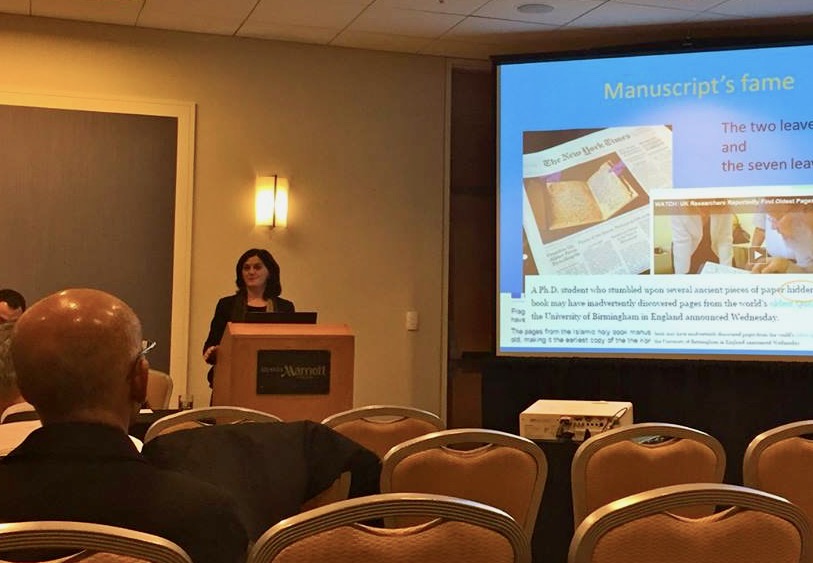Suggestions for Presenting a Conference Paper at IQSA
With the IQSA Annual Meeting quickly approaching next month, there has never been a better time to catch up on Dr. Devin Stewart’s (Emory University) suggestions for effective presentations at academic conferences!
Attendance at many conferences over the years and observing the presentations of both neophytes and older scholars has proved to me that nearly no one is taught in explicit terms how to write or deliver a conference paper. For the most part scholars have learned by osmosis, watching examples, whether good, middling, or bad. It is my hope that the scholars who participate in IQSA will be able to rise above the sea of mediocrity and make excellent presentations. I have witnessed a number of papers at IQSA that fall short of that mark, and while such lapses are not more prevalent at IQSA than at other conferences, my hope for the performances at IQSA is that they will be exceptionally high.
[The following statements represent my own considered opinions. It does not represent the opinion of the IQSA board or any other identifiable body in academia. My intention in presenting these comments and guidelines is only to help improve the quality of papers at the annual conference and thus to improve the experience and edification of all conference attendees.]

Alba Fedeli presents her work on the “Birmingham Qur’an” manuscript at the 2015 IQSA Annual Meeting in Atlanta, GA.
Purpose:
The main purpose of a conference paper is to announce to the world a new result that you have discovered. In practical terms, it is also to force you to write something, or to finish writing something, that you will publish, and to get feedback from scholars in the field before you do so. If you are lucky, members of your audience may alert you to problems in your argument, plausible counter-arguments, sources you have overlooked, or relevant secondary studies you have not come across. They may push you to explain your argument better, more clearly, or more precisely. All of this will help improve the resulting publication and help ensure that you do not publish something that is unoriginal, incompletely documented, or badly argued.
Content:
A conference paper should be a report about completed research that 1) is new, 2) makes a solid argument and 3) emphasizes concrete results. Especially for this society, 4) concrete results primarily consist of concrete conclusions regarding the text of the Qur’an, its meaning, or its historical interpretation and use. This definition has several implications that may go against what young scholars have been told by their sophomoric graduate student peers or benighted advisors and what they have seen performed by droves of misguided conference-goers.
- The content of your conference paper should not have been published before. It should be a new contribution to the field. You should not deliver a paper that is an info-mercial for your latest book. You should not present something that is an article already in press.
- A conference paper is a report about research that you have completed. It is not a verbatim, blow-by-blow transcript of the publication you intend to complete. You do not have time to read the entire article or book chapter that you are working on. You are presenting the news story about the project you have completed. Emphasizing the results.
- A conference paper should not be an interim progress report. While in many organizations, researchers and scholars present such reports as conference papers and lectures, doing so is akin to submitting one’s tax forms or an application for a business license. Many papers produced as part of a government-funded project or by scholars working in teams or for industry are presented as evidence that the project is moving forward and producing tangible results. However, unless the project has reached the point where there are actual results and conclusions can be drawn, it is not yet time to inflict it on the audience. It is acceptable to present something that is not 100% complete, or in which the conclusion is tentative or provisional. It is not acceptable to present something that has no identifiable conclusion yet. One should avoid presenting something that simply states that we have reached the middle of our work, this is the procedure that we are following, and this is where we stand. That is just shop-talk.
- A conference report should not be a plan for or introduction to research that will be carried out in the future, a prolegomenon, the equivalent of the introduction to a dissertation, a book, or an article. Papers that do this are quite frequent, and leave one asking, “Where’s the beef?” Avoid presenting an introduction to a blank.
- A conference paper must have a conclusion. Show and tell is not enough. No matter how fantastic the manuscripts you have to show are, it is insufficient merely to describe them. You must explain what they tell us that we did not know before about something greater: the historical transmission of the Qur’ān, its textual variants, patterns of copyists’ errors, and so on. A negative result is still a conclusion; it can make for a good presentation if it is interesting for some particular reason.
- If you must present the theoretical background or describe a controversy in order to frame your results, do it quickly. An excessively long wind-up is one of the most common faults of conference papers in general. If you write an article or the introduction to your book or dissertation, you can take the time to write at length, but in a conference paper, a long introduction merely delays and in some cases completely displaces the concrete results, which is a disappointment for the audience.
- Do not leave out the concrete results. Your colleagues in the field are most interested in these, and if you don’t get to specific results, you are robbing them. Include as many results as you can explain well in the time allotted. If you only have only a few examples, then you can spend some time. If you have many examples to choose from, select examples that are representative and can stand in for the others. A long wind-up to a simple and small example is disappointing.
- Your paper should take into account the relevant scholarship in the field. There may be too much for you to address in your presentation in any detail, but you should briefly indicate that you are aware of it. Especially in Qur’anic studies, there is a problem with reinventing the wheel. Do not assume that your idea has not been said before. Consult other scholars about the studies that might be relevant, especially studies in German and Arabic.
Structure:
- Problem or issue.
- Earlier scholarship on the issue, presented briefly.
- Your sources, method, approach, briefly
- Your results, conclusions [This should be the main part.]
- Implications
Presentation:
The single biggest problem with conference presentations in general is that presenters read a prepared text that was written as if it were a journal article or a book chapter. If you read a prepared text, you must write it to be read aloud in the first place. Most scholars are not trained to do this type of writing. Doing so is a skill on its own, and it takes practice. An alternative is to prepare notes, a handout, or a power-point presentation, and to speak to the audience from these notes.
If you use power-point, do not read out paragraphs of text from the power-point slides—this is an insult to the audience, whom you are accusing of being inattentive or lazy.
Speaking to the audience directly is about ten times better and more engaging than reading, unless you can write like P.G. Wodehouse. Unfortunately, speaking directly to the audience is a road not taken by 80-90% of conference presenters in all fields, and not just ours.
-Dr. Devin Stewart, IQSA President Elect (Emory University)
© International Qur’anic Studies Association, 2018. All rights reserved.
